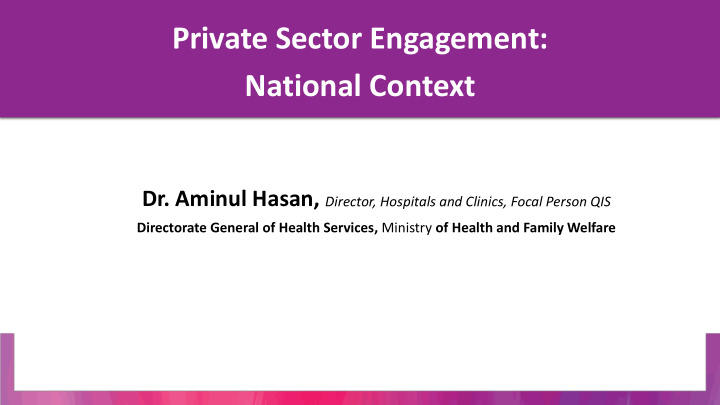



Private Sector Engagement: National Context Dr. Aminul Hasan, Director, Hospitals and Clinics, Focal Person QIS Directorate General of Health Services, Ministry of Health and Family Welfare
Healthcare in Bangladesh Universal Health Coverage ❑ To Increase Accessibility to the poor ❑ To Improve Quality of Care ❑ To Remove the financial barrier WHO: Universal right to high quality health care
Deaths due to poor quality High quality health systems could save over 8 million lives each year in low- and middle-income countries – 5 million due to poor quality alone. (Lancet Commission HQSS 2018)
Gap Model of Service Quality Expected services Gap 5 Perceived services Gap 1 External Service delivery Gap 4 communications Gap 3 Service standards Gap 2 Quality Improvement Hospital perceptions Secretariat. MOHFW of patient expectations
Journey from QA to QI Paradigm shift Quality Improvement (QI) Quality Assurance
Conceptual Framework for Quality Improvement Plan 3 rd Step Total Quality Improvement & Clinical Governance • Clinical Audit in different area. • Use Patient safety Guideline • Continued professional development • Introduce IPC Guideline • introduce clinical management • Safe Surgery Check List protocols & guideline for different • Risk Management discipline 2 nd Step • Practice Evidence based Medicine. • Use Clinical Indicators • Develop Clinical Microsystems approach • Periodic survey. CQI • RMNCAH Indicators • Formation of different clinical • MNCH Plan subcommittee • Performance award • Forming QIC & WIT • Apply National Health Care Standards • Situation Analysis by using specific • Using Facility Level Indicators (FLIS) check list. 1 st Step • Use SOP of Different services • Capacity Development of service • Follow MWM guideline provider 5S+ • Use of QI tools for public health, FP and • Develop 5S action plan field services • Use 5S monitoring check list • Introduce performance award • Periodic Survey
CQI during COVID-19 COVID-19 has presented us with a unique set of challenges ❑ Additional pressure on an already stretched system ❑ Constraints on manpower ❑ Disaggregation of bed capacity and operational changes to provide safe, effective care ❑ Ensuring appropriate maternal and newborn care during COVID Interventions ❑ Maternal and Newborn National guidelines for care during pregnancy, labor and delivery and post natal care ❑ Patient Experience survey for 2 dedicated hospitals in Dhaka
Context: Private Sector Care Provision ❑ Private Sector plays a significant role in the provision of healthcare in Bangladesh ❑ Providers exist at all tiers of the healthcare delivery system from primary through to tertiary, specialized and diagnostic care ❑ Private Sector regulation is being explored through a robust accreditation system For Maternal Newborn care in Bangladesh, Private Sector: ▪ Contraceptive supply accounts for 49 percent of modern method users ▪ Pharmacy or drug store is supplies 45 percent of users ▪ Prominent source of antenatal care (ANC), both in urban and rural areas. Overall, 58 % of ANC seekers went to the private sector to receive checkups (BMMS 2016) ▪ 84% percent of deliveries in private facilities were by C-section private facilities increased from 22% to 32% (BDHS 2017-2018)
A platform for shared public – private learning: BSQua In 2019 – a group of like minded people came together to develop a society dedicated to Quality of Care in Bangladesh Bringing together the public and private sector under one umbrella the society is a membership based non-governmental and not-for-profit organization focused on ensuring that quality remains at the core of all healthcare service delivered in Bangladesh
Private Sector Engagement: Vision for the future National ❑ Formation of BSQua and its early functioning ❑ Sensitization with private sector providers ❑ Engagement through professional associations ❑ Support high volume private facilities to implement QI initiatives in Dhaka and beyond ❑ Program Certification and Accreditation District ❑ Mapping of private facilities in Districts focused on MNH services ❑ District level advocacy meetings on QoC ❑ Capacity-building for high volume MNC facilities to implement QI ❑ Indicator monitoring and ongoing data sharing ❑ Support sharing of learning and experiences
Recommend
More recommend